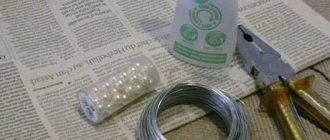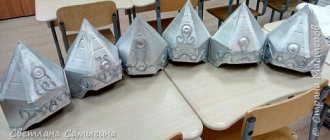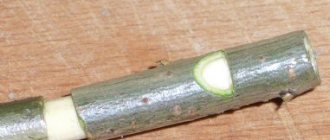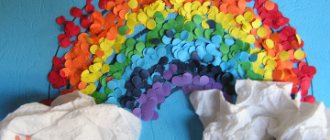The school education system involves introducing children not only to the basics of mathematics and the rules of their native language, as well as many sciences, but also close cooperation between the child and nature. Children are often given the task at school to collect their own herbarium. And parents are faced with a problem: how to help their child? There are a few rules you need to know. And, of course, you need to show imagination and creative thinking.
Other interesting articles:
Topiary of autumn leaves
Autumn bouquet of sweets
Bogorodskaya toy
Composition from autumn material
Autumn is rich in natural material in the form of leaves painted in different colors. You can use them to make an amazingly beautiful rose. You need to prepare fresh leaves with a long stalk. Dry leaves will bend and break, so they are not suitable for crafts.
Required material: 5-7 leaves of different sizes, threads.
- We select the smallest of the collected leaves, fold it in half horizontally, twist it - we get the middle of the flower.
- Fold the second leaf horizontally and wrap it around the first one.
- Wrap all the leaves like this.
- Spread them in the form of petals, tie all the cuttings together.
- Make several of these “roses” and make a bouquet out of them. For greater beauty, you can add fresh or dried flowers, rowan, and twigs.
- Before work, you can set a goal: to make roses of different colors. Then you will have to arrange the leaves into piles: red, yellow, burgundy.
Vegetable or fruit bouquets
Such bouquets have become fashionable these days; many people make them to order. You can create them from autumn fruits. It is advisable to select ones that are not very large and definitely beautiful to look at.
Ideas using tangerine, rowan, apples, and bird cherry are popular.
Asters, birch bark, leaves, twigs of coniferous trees, pine cones, and berries look good as additives. Instead of a vase, pumpkin, zucchini, even peppers and garlic are great. Small fruits are used to create unique autumn compositions.
Making ekibana about autumn with your own hands in a master class
In any case, it is very important to properly prepare the source material. In order for the ekibana of autumn leaves to look beautiful, you need to choose only whole and healthy leaves. You need to dry the leaves between the pages of a book or album, pressing them down with a weight. This must be done in order to avoid curling of the leaves in the future. Autumn leaves prepared in this way are used for children's applications, leaf collages, and also for herbariums.
If there is a need to make a volumetric composition, autumn leaves are soaked for three to four days in a solution of glycerin (200 ml) and cold water (400 ml). When treated with this method, autumn leaves become flexible, pliable and do not lose their original beautiful appearance.
There are four ways to dry leaves for flat crafts:
- Natural method. The collected natural materials are tied into bundles and hung on a thread in a dry, well-ventilated area.
- Hot iron drying. Autumn leaves are laid out on thick cardboard, thin paper is placed on top and carefully ironed with a hot iron. It is necessary to iron until the moisture from the leaves has completely evaporated.
- Volumetric drying. With this method, autumn flowers best retain their shape and volume. The flower is cut and placed in dried and calcined sand for one month.
- Oven drying method. It is necessary to set the oven at a very low temperature, about 60 degrees Celsius. The prepared natural raw materials are laid out on a base and slowly dried. You should always monitor the condition of the leaves and flowers to prevent them from darkening or losing their shape.
Autumn ekibana can be decorated in a decorative vase, basket or artificial stand. You can approach this issue very creatively and creatively: use a pumpkin or a small hollowed out log instead of a vase.
The process of creating an autumn ekibana depends entirely on your imagination and desire. You can add unusual, varied elements to your composition. However, before you make an ekibana, you need to know that the primary task is to form the base or “backbone” of the composition. It needs to be thought through immediately. This will allow you not to forget what result you are striving for, what your initial compositional idea was. After this, you can completely surrender to creative impulses and ideas: add dried flowers, cones, berries, acorns, roots and leaves. The most important thing is that the final result looks harmonious and that all the constituent elements of the composition are combined with each other.
If you want to create an autumn ekibana with your own hands, on the Internet you will find many photos with various design ideas.
To secure the autumn composition, it is best to use plasticine or foam rubber, which must be placed in the selected container.
As you can see, a DIY autumn-themed ekibana will be a great addition to the interior of your home. Start creating it with your children. For children, schoolchildren and even adults, this activity will be fun and exciting.
Pumpkin as a vase
In this capacity, the vegetable fits perfectly. But what about water for a bouquet? A floral sponge or a tin can will come to the rescue.
We free the pumpkin from pulp and seeds. Instead, we place a floral sponge. We fill it with water and put a bouquet in the pumpkin.
Another option for a bouquet of fresh flowers is a tin can (or glass).
Ribbons and braid will help decorate a vegetable vase. Bouquets using spruce (pine) branches, bird cherry and rowan bunches look beautiful in it.
Fantasy will help you use all the materials that are around you to make bouquets. The more creative you are, the more entertaining your crafts will be.
Ikebana “Autumn” with your own hands
Ikebana is usually made from natural materials: dry and fresh flowers, leaves, branches. It is very unusual to make ikebana from tree leaves and vegetables (cabbage, parsley, celery). Ikebana will turn out to be unexpected and interesting if you use autumn berries and fruits planted on branches. From the article you will learn: the basic rules for creating ikebana and how to make autumn ikebana with your own hands.
Rules for drawing up ikebana
When composing ikebana, you must remember that ikebana is not a bouquet; it does not tolerate pomp. Ikebana is based on three symbolic elements: shin (sky), soe (man), hikae (earth).
Ikebana is built according to the following rules:
1. All elements are installed asymmetrically, forming a triangle, and the elements must be in different planes.
2. The ikebana vessel must match the plant material used, be plain and without a pattern. Rough ceramics are suitable for heavy flowers and large branches; wildflowers look good in earthenware or wooden vessels and in wicker baskets; for roses, tulips, carnations and lilies of the valley - glass or porcelain vases. You can use any objects you like as a “vase”.
3. The proportions of the three main elements are predetermined by the size of the vessel: the length of the stem of the first element - palate (syn) - is equal to the sum of the length of the diameter and the height of the vessel multiplied by 1.5.
4. Correlation and arrangement of symbol elements:
- man (soe) should be equal to 2/3 of the sky element (sin), and they are inclined to one side;
- the branch of the earth element (hikae) should be 2/3 of the length of the person (soe) and placed in front or slightly shifted in the opposite direction from the other two elements;
- all elements are fixed in ikebana so that they appear to be branches of one plant.
5. The branches in the vessel are always fixed at one of four points: right, left, front, back. To do this, use a special device for fixing flowers - kenzan or piaflor (porous sponge); if they are not available, then use plasticine or a plastic bag filled with expanded clay.
6. After the location of the main elements, the space is filled with plant material of the second degree of significance.
Master class: do-it-yourself ikebana “Autumn”
- 2 branches of cymbidium orchid;
- "tingi" branches;
- tall narrow vase 30 cm high;
- glass balls;
- pruner, scissors.
- Fill the vase halfway with glass balls.
- As a hikae, we take a strong branch of a cymbidium orchid, about 50 cm high, with a slight bend to the left.
- Place the hikae in the vase so that the base of the stem touches the bottom of the vase, and tilt the branch to the left by 15°.
- As a syn, we take an orchid branch with a stem of almost 60 cm and also place it at an angle of 15°, tilting it to the right side.
- We place the “tingi” branch in the vase almost parallel to the sin, and tilt it slightly back to the left, behind the hikae.
Ikebana “Autumn” is ready.
Master class: do-it-yourself autumn ikebana from nature’s gifts
- mini pumpkin;
- branched beautiful branch without leaves;
- rowan sprigs;
- cones;
- dried leaves;
- chestnuts;
- heat gun;
- gloss for leaves of indoor plants.
- We cut off the bottom of the pumpkin evenly, make a small hole in the top and, if possible, clean the pumpkin of seeds.
- We glue the cones with a heat gun to the ends of the branches of the main branch;
- We insert and secure the main branch into the pumpkin, and decorate the top hole of the pumpkin with rowan branches.
- Glue the dried leaves and small branches of rowan in several places onto the main branch.
- To add freshness to the composition, we treat it with glitter for indoor plants.
- To create a complete composition, we lay out a carpet of leaves and chestnuts on the table, and place our ikebana on top. Our autumn ikebana is ready.
Arranging ikebana is an art that takes a long time to learn in Japan. Try, experiment and you will definitely succeed.
Paper compositions “Golden Autumn”
Paper is used to create autumn-themed bouquets. The first step is to prepare flowers. Here you can use the origami technique, make simple roses and paper tulips.
An excellent addition would be colorful autumn leaves or leaves created with your own hands from paper.
Package
If you are making an autumn bouquet with your own hands for school or as a gift for someone, you need to decorate it beautifully. There are many types of packaging. To decorate an autumn bouquet of flowers you can use:
- plastic film with and without pattern;
- Sizoflora;
- organza;
- floral mesh.
You can decorate the bouquet with ribbons, lace, and braid. Try to choose a package that only complements the flowers, emphasizes their beauty, but does not attract all the attention.
Autumn bouquets for kindergarten
For kids I offer simpler ideas. Suitable materials include cones, peanut and pistachio shells, dried pumpkin seeds, and dried flowers.
Fir or pine cones
They themselves resemble flowers. If you find unopened cones, you need to leave them in water to swell. Then they will open up on their own.
The cones attach well to decorative skewers and toothpicks. You can use regular polyurethane foam and make round balls out of it. They are used as a stand for plants or materials that can be easily stuck into them.
A unique bouquet will be made from pine cones turned upside down. Attach beads, beads, rhinestones, and ribbons to the ends using hot glue.
A composition of pine cones painted in bright colors with gouache or spray paint will look nice. If after painting the brown tint cannot be covered, you need to apply several more layers.
Pumpkin seeds
They will become flower petals. Seeds can be glued in several rows on paper. Simply paint the core, create it from a piece of colored cotton wool.
Taking plasticine as an additional material, we get daisies or other flowers. Roll into a ball of plasticine and insert rows of pumpkin seeds. The size and color options can be varied to suit your taste.
We use dried flowers
These are unique plants. They are alive, but there is almost no moisture in their petals. Such a flower, placed in a vessel without water, becomes dry very quickly, but at the same time it retains the shape of the bud and all the shades of the petals. The following plants can be used:
- yellow-orange helichrysums;
- white helipterums;
- xeranthemums (their petals are pink, coral, red);
- immortelle.
The brightest and most beautiful dried flowers are kermeks. There are about 300 species of them. Each has its own flavor. Ears of ears perfectly complement compositions of autumn flowers. They are usually yellow in color. However, you can make them blue, red, green. To do this, you just need to cover them with acrylic paint.
Wreath for the front door
This is a kind of bouquet, round in shape, which can be used to decorate a door, a gate, or simply put on a table. It’s not difficult to create, just make a circle out of cardboard or wire and start covering it with leaves, acorns, rowan branches and other berries. We put all this on glue, silicone is an option. A glue gun is even better.
Autumn bouquet with ears of wheat
Another idea for an amazing bouquet is a combination of tea roses, orange, cream or yellow lilies with green leaves, those that have not yet changed their color. You can complement the bouquet with ears of wheat or ordinary ears of wheat that grow everywhere. We secure the result with tape and decorate the ambassador with a wide ribbon.
Dry bouquet
This is for those who want to extend autumn and not say goodbye to it even in the cold. This composition will not even need to be watered. For this we need dry branches, which we paint with paints in any color, dry leaves, reeds, acorns. All this is assembled and glued as desired and installed either in a flowerpot, in a vase, or in a basket. Such a still life will not leave anyone indifferent. More ideas for crafts and bouquets of dried flowers.
Autumn bouquet without flowers
Yes, imagine, this happens, isn’t it, it’s just magic. In the basket, at the bottom, we put spruce branches, along the edges of the basket, we attach cones, they can be painted gold or silvered. In the center there will be rowan, pomegranate, bunches of grapes and a lot of yellow and orange leaves. It would be wonderful if the bouquet included interspersed sea buckthorn branches, dry ears of rye, and rose hips. What else can be made from pine cones.
We use berries and fruits
Autumn not only paints gardens and parks with bright colors. She generously gives us fragrant, juicy and tasty fruits. If you need to make an autumn bouquet for a children's party with your own hands, you won't find better natural material. You can use everything that grows in the garden.
There are no restrictions on the selection of components. Apples, plums, pears, melons, watermelon, and grapes are suitable. Strawberries are very decorative, but they are difficult to find in the fall. If desired, domestic fruits can be supplemented with overseas ones. They are sold in supermarkets all year round.
You can make a bouquet from whole fruits by pricking them onto wooden kebab sticks. However, all kinds of figures look more interesting. To make such a bouquet you will need:
- fruits and berries (apples, watermelon, melon, grapes and others, which are available);
- berries;
- chocolate bar;
- metal cookie cutters;
- lettuce or parsley leaves (sprigs of evergreens also work);
- knife;
- wooden sticks;
- tablespoon;
- beautiful packaging.
Simple autumn bouquet
And finally, if you are not in the mood to make something, but the desire for a drop of autumn to appear at home exists, take a walk along the street and simply collect the gifts of nature. Pick a couple of autumn leaves, a branch of rosehip, rowan, look for sea buckthorn, pick flowers, collect it all in a huge bouquet and put it in a vase at home. Place a fragrant candle nearby and enjoy the resulting still life. We hope that the proposed ideas inspired the reader to create at least one small autumn masterpiece.








